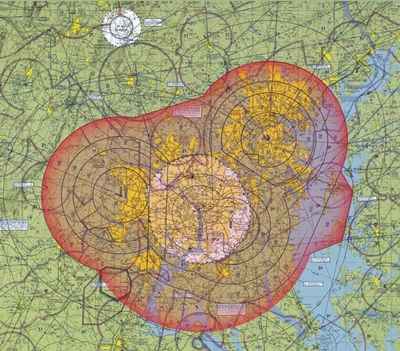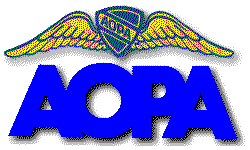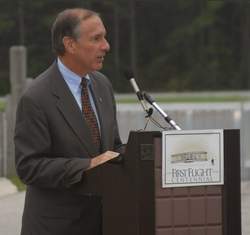Sat, Mar 15, 2003
Still Searching For Accommodation
AOPA President Phil Boyer sent a series of recommendations to
the FAA and TSA to help alleviate problems encountered in the
Washington, D.C. Air Defense Identification Zone (ADIZ). This area
encompasses airspace within a 30-mile radius of Washington. The FAA
and TSA told AOPA late Thursday they are "actively considering" the
proposals.

AOPA: We Hate To Say We Told You So, But...
When the ADIZ was established in February, AOPA made several
predictions that it says have proved true. On the first weekend of
good weather since the ADIZ was announced, dozens of extra flights
were added to the workload, overwhelming the air traffic control
system. In literally hundreds of instances, the system failed
pilots and air traffic controllers. This resulted in confusion,
frustration, and, during certain times, absolute gridlock as pilots
waited on the ground with engines running or in the air circling
for interminable periods of time. The central problem was receiving
a special transponder code that permits operations in the
Washington (DC) ADIZ.
 The
recommendations were established based on the real-world
experiences reported to a special email address set up by AOPA in
anticipation that there would be problems. More than 150 members
responded with their weekend flying experiences, and the
association began developing a set of recommendations to address
the operational problems to reduce the burden on pilots and
controllers, while maintaining security.
The
recommendations were established based on the real-world
experiences reported to a special email address set up by AOPA in
anticipation that there would be problems. More than 150 members
responded with their weekend flying experiences, and the
association began developing a set of recommendations to address
the operational problems to reduce the burden on pilots and
controllers, while maintaining security.
In a letter to executives of FAA and TSA, Boyer proposes four
specific suggestions:
- Reduce the number of requests for transponder codes by
assigning discrete codes for each airport within the ADIZ; one for
arriving aircraft, a second for departing aircraft, and a third for
aircraft staying in the pattern at the airport.
- Establish corridors to and from each airport for aircraft
operations. Also, have a specific radio frequency for pilots to
monitor while in the corridor, reducing contact with air traffic
controllers to only upon request.
- Establish a "cutout" of the ADIZ for Bay Bridge Airport, which
is at the fringe of the controlled area.
General aviation flights not originating in or departing the ADIZ
would be encouraged to avoid transiting the ADIZ.
 Boyer
(right) pledged AOPA's help in getting information to pilots. He
said if these important changes are made, "AOPA will work
diligently to distribute the information to pilots and to publicize
the simplified rules." This would include physically getting
posters and other material to the affected airports and extensive
use of AOPA's electronic outreach.
Boyer
(right) pledged AOPA's help in getting information to pilots. He
said if these important changes are made, "AOPA will work
diligently to distribute the information to pilots and to publicize
the simplified rules." This would include physically getting
posters and other material to the affected airports and extensive
use of AOPA's electronic outreach.
Traffic Jam
The occurrences over last weekend resulted when the air traffic
system was unable to support the operational needs of general
aviation flights in the area; this, despite diligent work of the
staffs in the Baltimore and Potomac Tracons. John Carr, president
of the controllers association, told Boyer he supports AOPA's
solutions but added that if they were not all accepted by FAA and
TSA, additional controllers could be assigned to Baltimore and an
unused portion of the new high-tech, state-of-the-art facility,
Potomac Tracon.
More News
Airport Rotating Beacon A visual NAVAID operated at many airports. At civil airports, alternating white and green flashes indicate the location of the airport. At military airports>[...]
Aero Linx: Fly for the Culture Fly For the Culture, Inc. is a 501(c)(3) non-profit organization that serves young people interested in pursuing professions in the aviation industry>[...]
Klyde Is Having Some Issues Comprehending The Fed's Priorities FMI: www.klydemorris.com>[...]
Also: Viasat-uAvionix, UL94 Fuel Investigation, AF Materiel Command, NTSB Safety Alert Norges Luftsportforbund chose Aura Aero's little 2-seater in electric trim for their next gli>[...]
Also: EP Systems' Battery, Boeing SAF, Repeat TBM 960 Order, Japan Coast Guard H225 Buy Despite nearly 100 complaints totaling millions of dollars of potential fraud, combined with>[...]
 ANN's Daily Aero-Term (04.25.24): Airport Rotating Beacon
ANN's Daily Aero-Term (04.25.24): Airport Rotating Beacon ANN's Daily Aero-Linx (04.25.24)
ANN's Daily Aero-Linx (04.25.24) Klyde Morris (04.22.24)
Klyde Morris (04.22.24) Airborne 04.24.24: INTEGRAL E, Elixir USA, M700 RVSM
Airborne 04.24.24: INTEGRAL E, Elixir USA, M700 RVSM Airborne 04.22.24: Rotor X Worsens, Airport Fees 4 FNB?, USMC Drone Pilot
Airborne 04.22.24: Rotor X Worsens, Airport Fees 4 FNB?, USMC Drone Pilot





